
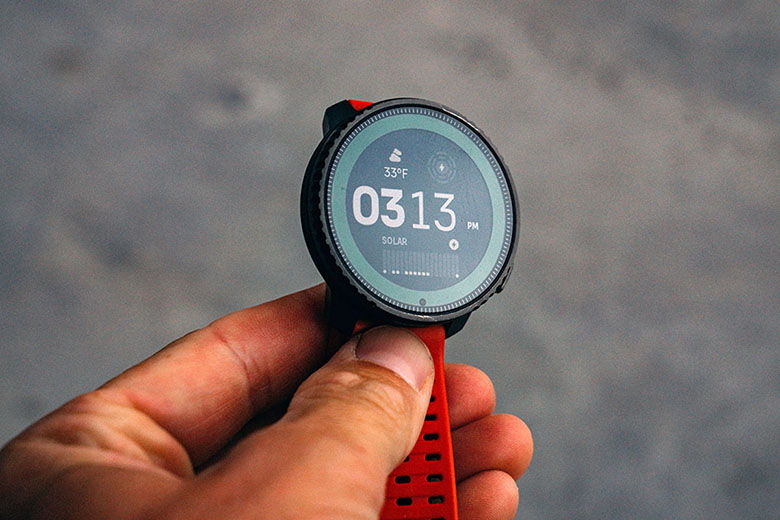
Price: $839
Weight: 2.6 oz.
Battery: Lithium-ion and solar
Diameter: 49mm
What we like: Long-lasting battery and great GPS accuracy; classy titanium design that crosses over well for everyday use.
What we don’t: Navigation falls short of high-end Garmin watches; only comes in one size, and 49mm might be too bulky for some.
See the Suunto Vertical Titanium Solar
In the past, Suunto’s attempts in the expedition-level watch category have fallen short of those from the likes of Garmin and Coros. However, with the release of the Vertical, the Finnish company has asserted its presence in the modern market and given endurance athletes and adventurers another stellar option to consider. Highlights of the Vertical include a highly competitive battery life, startlingly good GPS accuracy, solar charging, and a premium titanium build that looks good no matter where you take it. The watch can’t quite measure up to high-end Garmin models in terms of maps and navigation, but its long-lasting design makes it a competitive choice for serious athletes and adventurers taking on extended efforts. Below we break down our experiences with the Vertical Titanium Solar. To see how it stacks up to the competition, check out our articles on the best fitness watches and best GPS watches.
Editor's note: We updated this review on January 8, 2025, to expand our section on battery life, add in-text comparisons to the Garmin Enduro 3 and Coros Vertix 2S, and ensure all other information was current at the time of publishing.
Battery life is one of our main considerations in purchasing a fitness watch. Unlike standard time pieces, these are highly capable devices that use a lot of power and, as a result, need to be charged more routinely. The Vertical’s battery life is one of its top features, with a listed 90 hours (recording every second with dual-band GNSS) for the Solar version I tested. By tweaking recording intervals and satellite usage, you can extend this lifespan significantly—Suunto even advertises that the Vertical can last 500 hours in “Tour” mode, which records every 2 minutes and limits heart rate tracking, brightness, maps, and other features. For comparison, Garmin's similarly priced Fenix 7 Pro Solar lasts 26 hours using all satellite systems plus multi-band GPS, while their pricier Enduro 3 lasts 90 hours. In short, the Vertical's long-lasting battery life pushes it near the front of the pack.
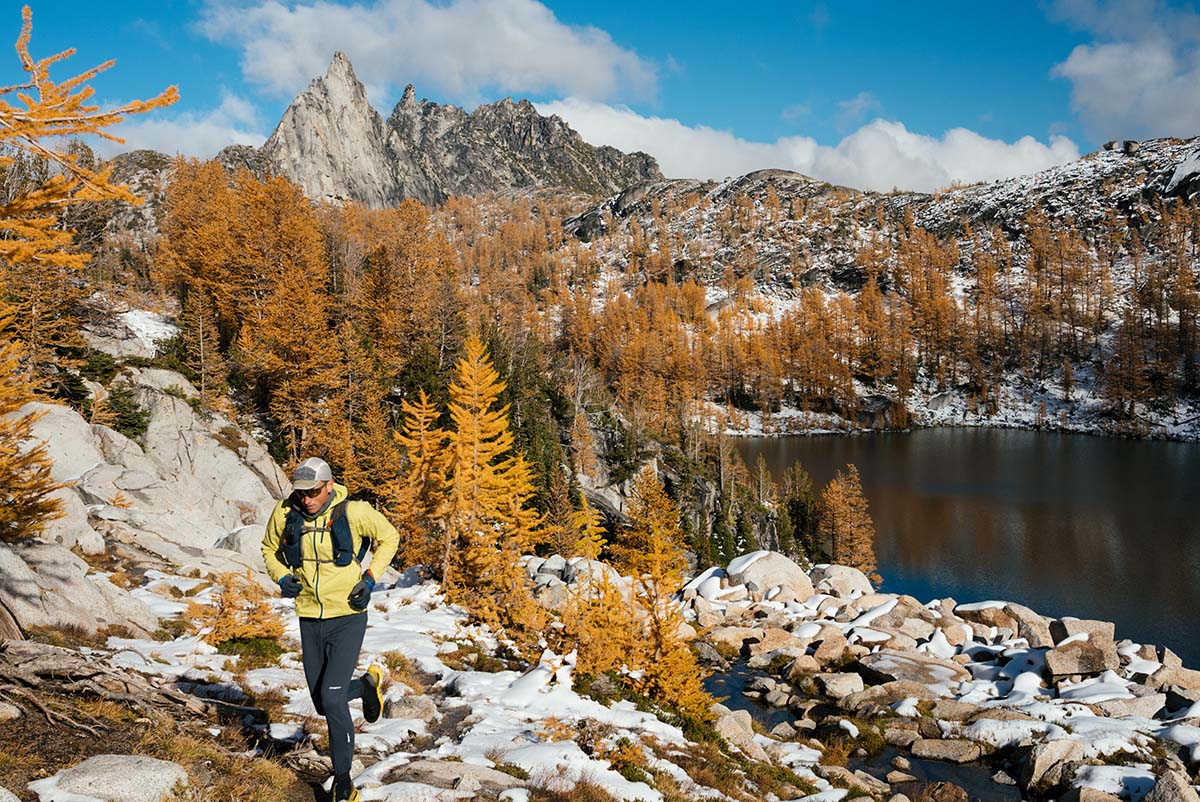
Of course, listed specs are just hypotheses until put into practice. In my testing, I was able to use the Suunto Vertical for about a month before needing to put it on its charger—roughly 60 hours of activity tracking with the remaining hours in time mode. Put simply, that’s insane. I also appreciated how at the start of each activity, the watch provides an estimate of how much battery life is left given the current settings. If you know you need more battery than it shows, you can select a longer GPS interval to make sure it will last for the duration of your activity. All told, the Vertical’s battery life is unmatched among current sports watches. While this will benefit every user, it’s specifically helpful for multi-day activities and expedition use, along with being a great match for long-course triathletes or ultrarunners who need a reliable timepiece that won’t die during serious efforts.
The Vertical comes with a charger that plugs into USB on one end and uses two metal rods to connect to the watch on the other. It emits a beep when you line it up on the charger, and you can also check by looking at the screen and see the charge icon across the battery symbol. However, although the rods are magnetic, the pull isn’t very strong and you have to take care to align the watch perfectly for it to connect. In the end, this was one of my big gripes with the Vertical: I didn’t have a great deal of confidence that it would stay attached to the charger when unattended.

Most users will be using the Suunto Vertical to track their activities first and foremost, so GPS accuracy is an essential trait. The Vertical is just about as good as it gets, with connection to GPS, GLONASS, GALILEO, QZSS, and BEIDOU satellite networks in addition to dual-band (also known as dual-frequency) GNSS. I’ve used the watch everywhere from thick, old-growth trees to narrow rocky canyons, and haven’t noticed any errant GPS tracks. For comparison, my single-band GPS watch’s tracks jump around in areas with obscured access to the sky.
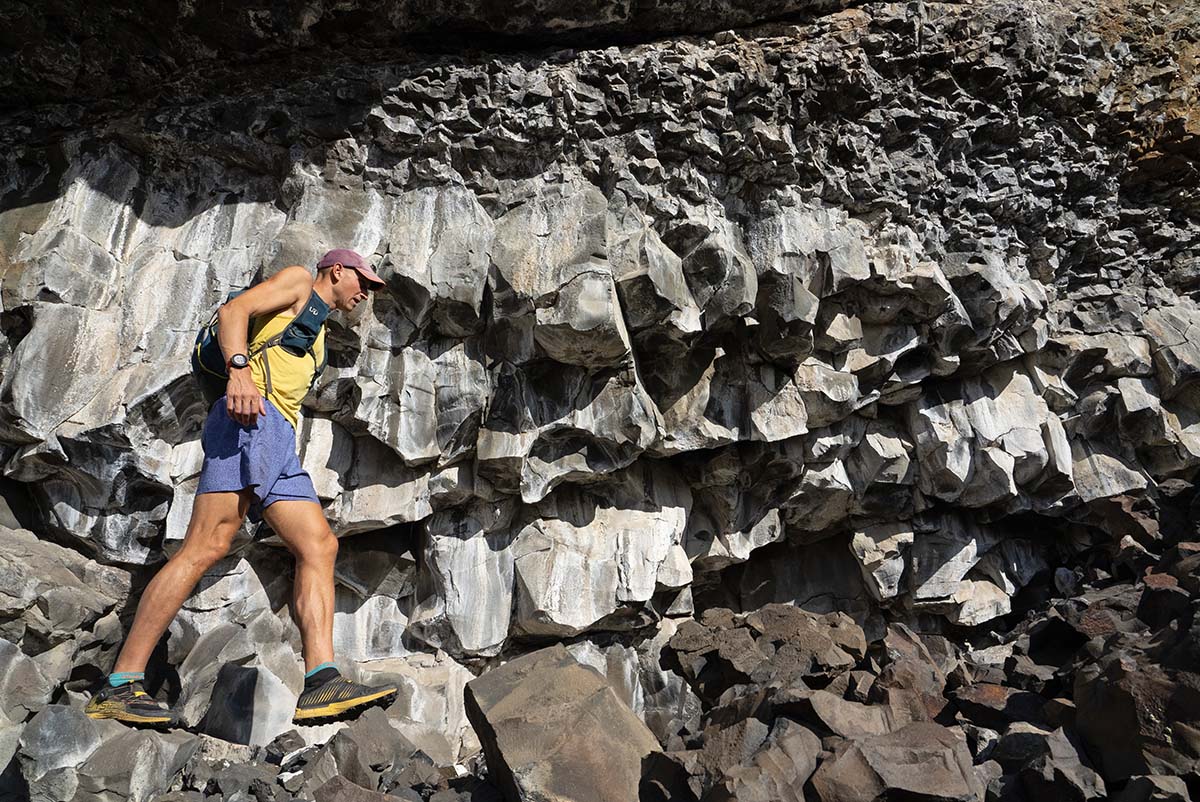
While most fitness watches offer serviceable accuracy, a high-end design like the Vertical will be worth it for those who care about precise data. I’ve noticed that the Vertical measures many of my routine runs with slightly more mileage and vertical gain than my previous watch, which makes sense if it’s collecting more accurate data along the route. Further, maintaining a steady pace is an important part of my training, and it’s nice knowing that I can truly rely on the watch’s speed (min./mile) and vertical speed (feet/min.) specs. And it’s not just about training—on one occasion, I used my up-track to retrace my steps down steep and cliffy terrain, and it proved to be very accurate. Recreational users probably won’t need this level of precision, but if you venture into areas with overhead cover (including downtown areas of cities), depend on your watch to retrace steps in technical terrain, or require precise numbers for training, the Vertical has a lot to offer.

The Suunto Vertical measures heart rate with an optical sensor—the same sensor used in the Suunto 9 Peak Pro. But while the 9 Peak Pro takes a measurement once every 10 minutes, the Vertical has the capability to gather data every second, which leads to greater accuracy. The heart rate data on its own will be interesting for many athletes, but Suunto also uses it to calculate HRV (heart rate variability), which is a helpful tool for recovery.
Optical heart rate sensors aren’t the most accurate way to measure heart rate (there’s a lot of variables that can skew the numbers, including a too-loose watch or obstructing arm hairs)—I’ll always use a chest strap when I want the most accurate data. That said, comparing the Vertical’s optical heart rate data with that of my Polar H10 chest strap (paired with my Suunto Ambit Peak 3 watch), the Vertical provided very similar readings. I did notice that the optical heart rate monitor often takes 5 to 10 minutes to get an accurate measurement when starting the activity, and the numbers tended to be high (compared to the chest-strap measurement) during downhill stretches of my runs.
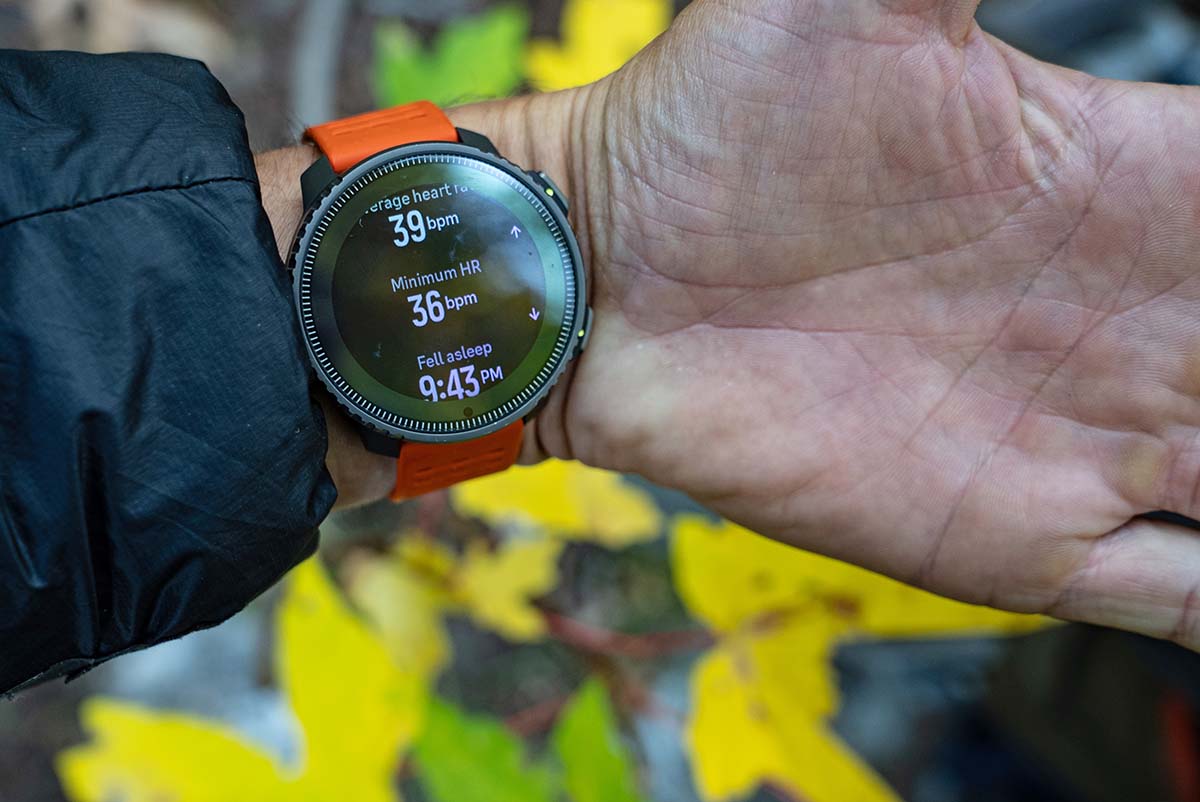
With over 95 sports modes ranging from running and trail running to swimming, snorkeling, and diving, the Suunto Vertical will be a suitable match for almost every athlete. And these sports modes are easy to customize, too. You can use the Suunto app to select the modes you want to see on the watch, refine the data screens to your liking, and even create your own unique activities (I created one called “wandering” for when I’m doing a mix of off-trail running and hiking). I did find the data screen customization to be less flexible than past Suunto watches (you’re limited to just a few templates) and would love to see more options added, such as graphs and repeat screen configurations with different data.
I haven’t used any of the swimming, scuba, or freediving functions yet, but with 100-meter water resistance, the Suunto Vertical can be used for most water sports. The watch also provides dive depth measurements down to 10 meters. This is a great feature for freediving, but scuba divers will still want a true dive-specific watch (like those in the Suunto D series). It should also be noted here that the Suunto Vertical does not support ANT+ sensors that you might find on older chest straps, cycling power meters, footpods, and more, although most modern accessories now connect via Bluetooth.
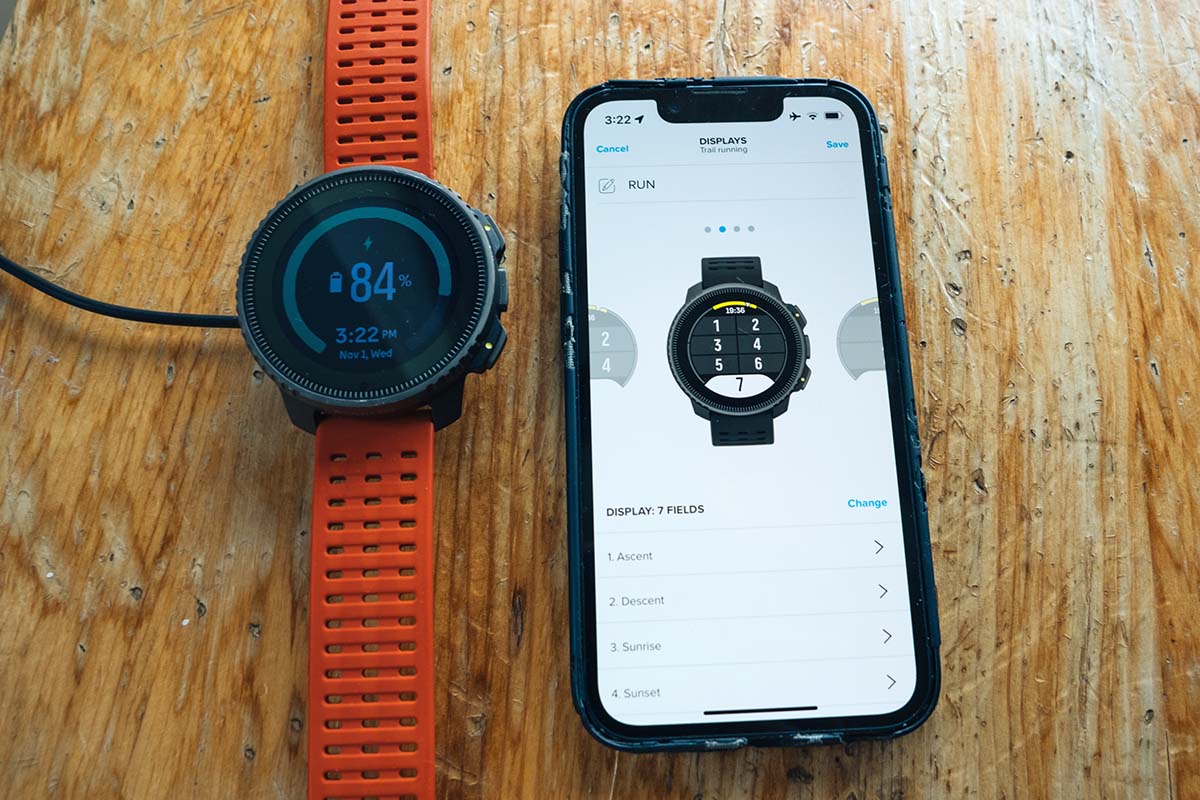
I’ve grown familiar with the Suunto interface from using my Ambit Peak 3 over the years, so adapting to the Vertical’s system was seamless. The watch uses both a touchscreen and side buttons to toggle between modes, and this redundancy never felt annoying or overkill to me. I also was surprised to find the touchscreen still worked well with raindrops on the face.
The watch’s display measures 49 millimeters in diameter, which is average to slightly above average for a watch face (for comparison’s sake, the Garmin Fenix 7 series comes in 42, 47, and 51mm options, while the Coros Vertix 2S is 50.3mm in diameter). Those with smaller wrists might find the Vertical to be a bit too large, but it was a great fit for me. I found the display to be bright and nicely contrasted, and it provided a clear view of data even in bright sunlight. You also get the option of choosing between different colors themes, along with backlight options for increased visibility.
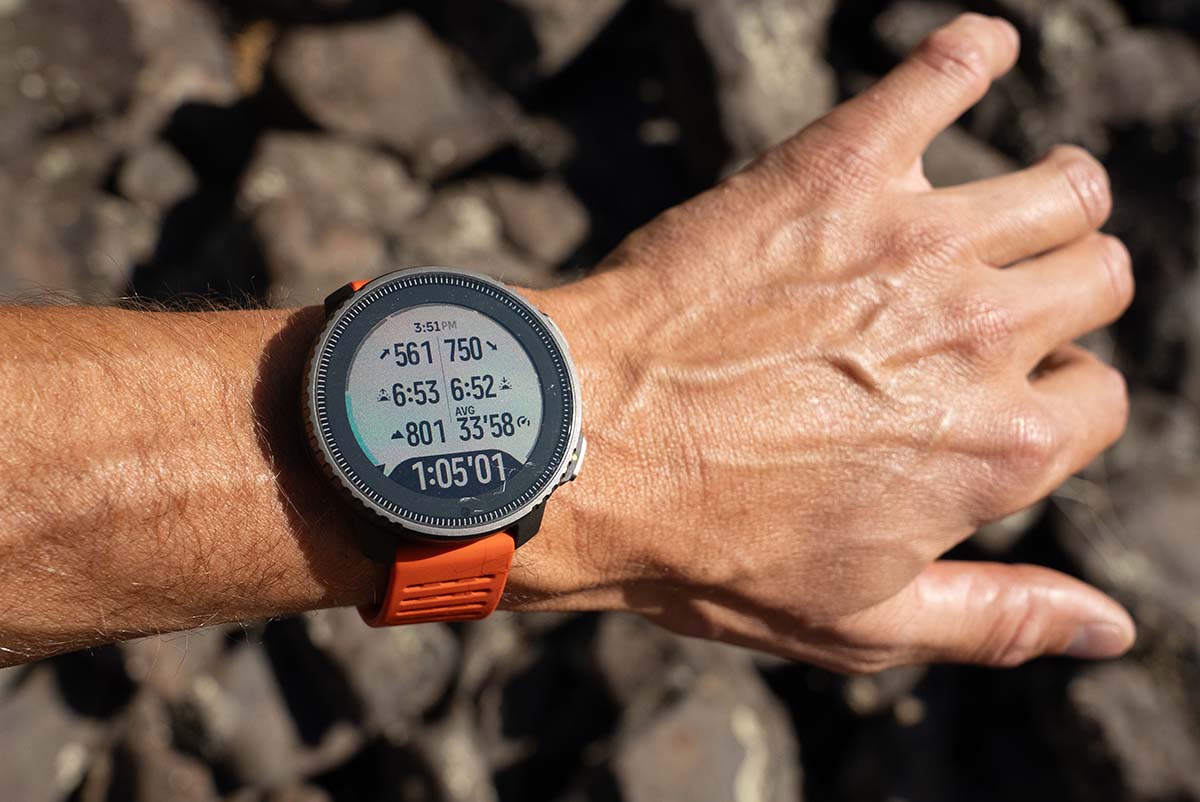
Suunto hasn’t always blown us away with their maps and navigation, but the Vertical steps it up with a full suite of wrist-based features. The watch offers downloadable topographic maps and 32 GB of map storage—enough for about half of the United States—which can be preloaded using WiFi (your watch also must be on the charger for this process). Suunto’s app makes it easy, with downloadable regions organized neatly by country. My main gripe is that transferring the maps to the watch can take a while—it took me 2.5 hours to download the state of Utah (1.38 GB)—an issue that Garmin solves by offering transfer via USB.
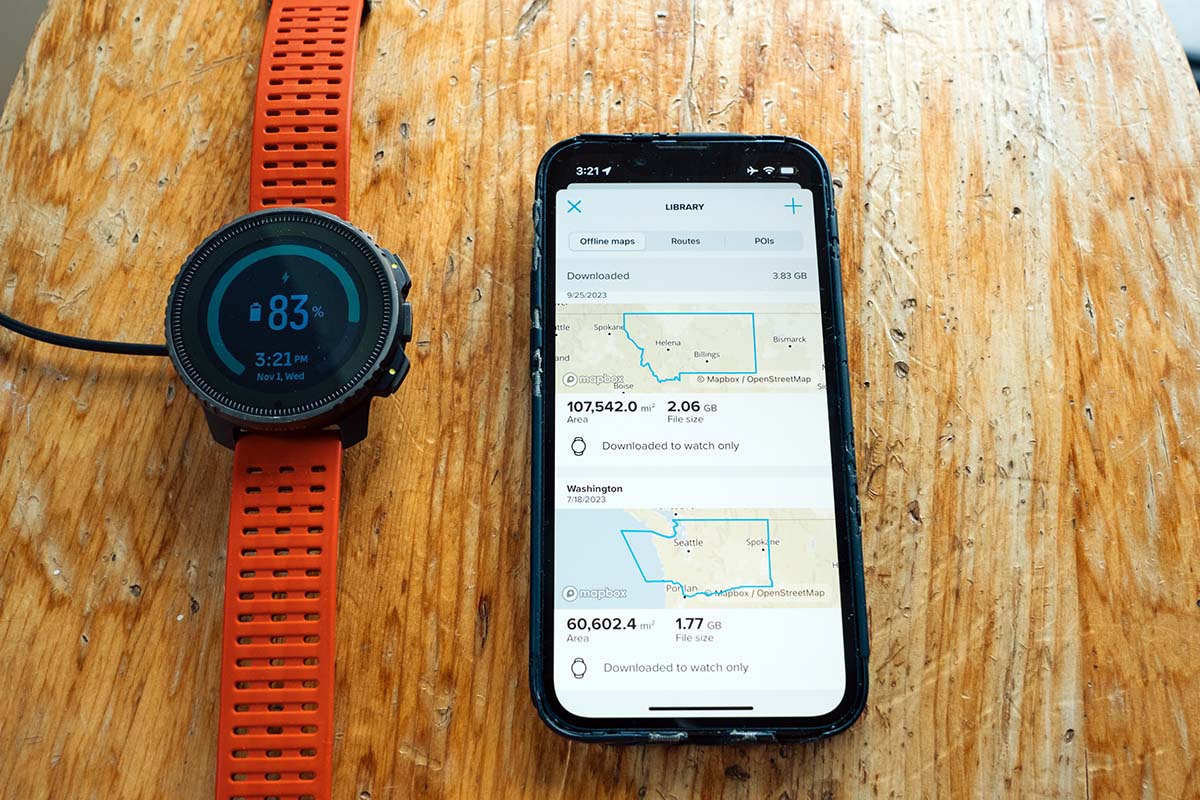
The Vertical’s mapping technology is not the most premium available, but it’s a big step up from a simple breadcrumb trail. Suunto uses “non-routable” maps; in short, your pin or track floats on top of a detailed topographic map rather than being inside of it like it would on a higher-end Garmin (like the Fenix 7 or Forerunner 955). This means the watch can’t provide turn-by-turn directions and rerouting à la Google Maps, although it is useful for helping you stay on your preloaded track.
In terms of the maps themselves, Suunto offers three types, packaged together: Regular Outdoor, High Contrast, and Dark. You can toggle through these options on the watch face and select what best fits the lighting where you are. Notably, the Vertical’s maps do not include location labels (for peaks, trails, creeks, etc.)—this is a pretty big shortcoming, and on more than one occasion it’s forced me to pull out my phone and consult Gaia. Coros’ Vertix 2S has the same issue, while Garmin’s high-end watches include place names. Finally, I wish the Vertical had the ability to display a slope angle layer on the map (extremely helpful to consult in avalanche terrain), although I have yet to see any watch with this capability.
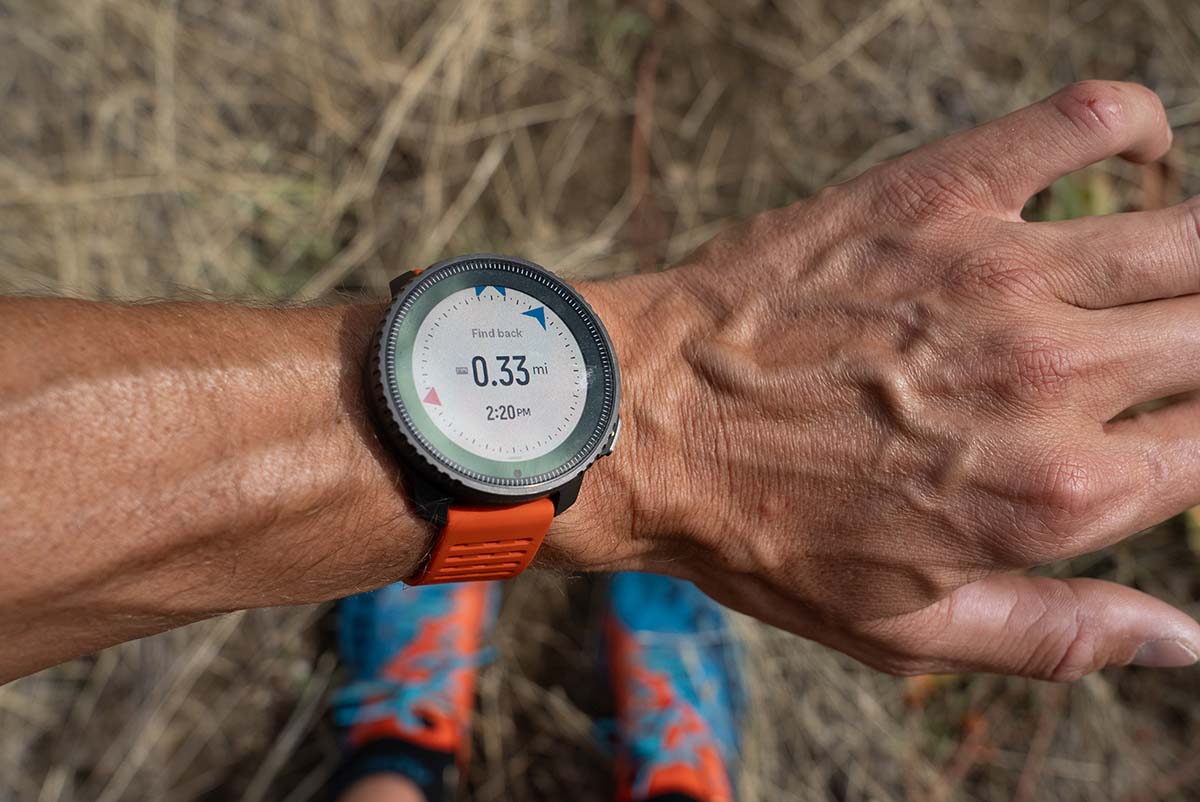
In addition to maps, it’s also possible to upload a premade track to the Vertical, which is then superimposed on top of the downloaded map. The Suunto app makes this process easy as well—after importing tracks from platforms like Strava or Gaia, it’s a quick transfer from the app to the watch. I have used this feature a lot for running races, as it’s a great way to get a quick glance of how far along your route you’ve traveled (including miles and elevation gain) and how far you have to go. I do wish that Suunto offered something like Garmin’s ClimbPro feature—a cool function that splits up the climbs and descents on the route and lets you track your progress on each individual section. Hopefully they’ll add a similar feature in a future firmware update.
In summary, if you depend on your watch for high-level navigation or like the idea of something like the ClimbPro feature, I’d instead recommend the Garmin Fenix 7 or Forerunner 955. But for the vast majority of users, the Vertical offers fully serviceable maps and navigation, and the ability to easily select regions for downloading is best in class.
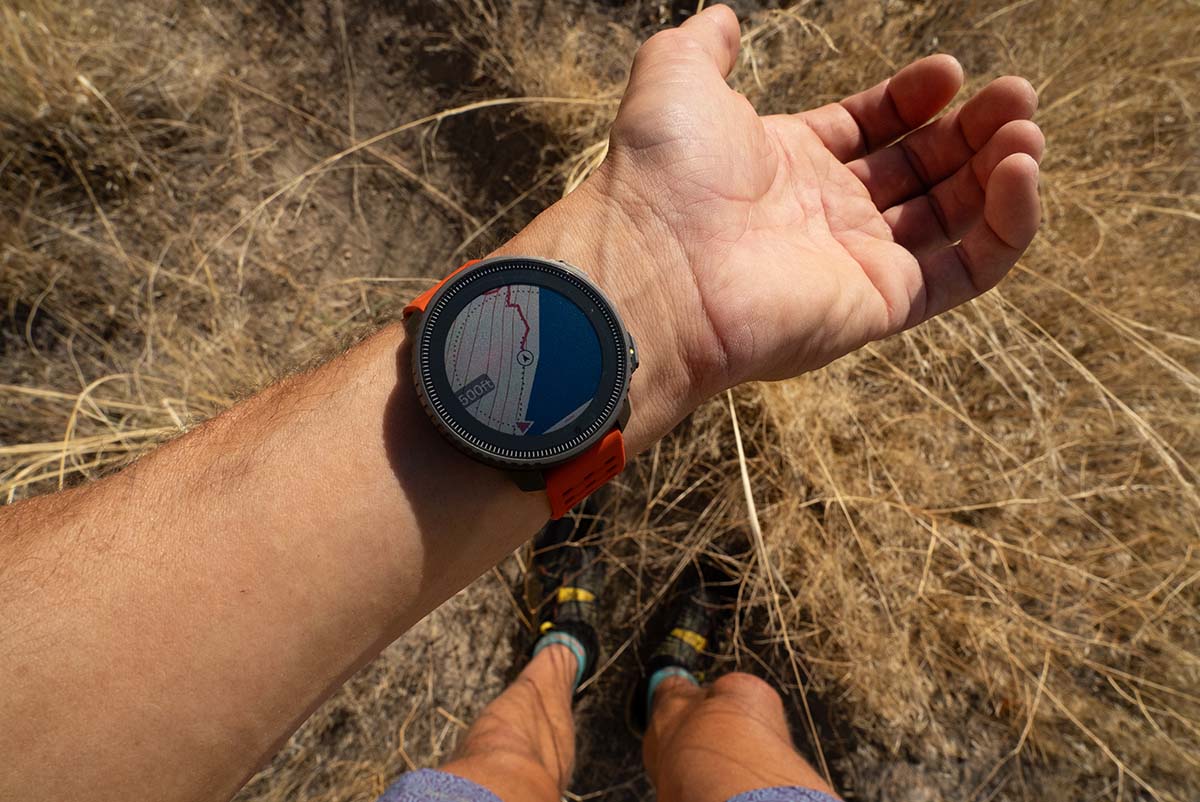
Notifications
Like most fitness watches, the Vertical can sync with your phone to deliver wrist-based notifications. I turned this feature off as I don’t like to have my emails, texts, and calendar reminders interrupting my runs. However, if you’re on call for work or family, it’s a very useful addition and allows you to keep your phone stored away in your pocket or running vest. The Vertical can be used to send a quick, preprogrammed reply with the click of a few buttons, but keep in mind that you can’t answer calls or type unique responses like you would with an Apple Watch.
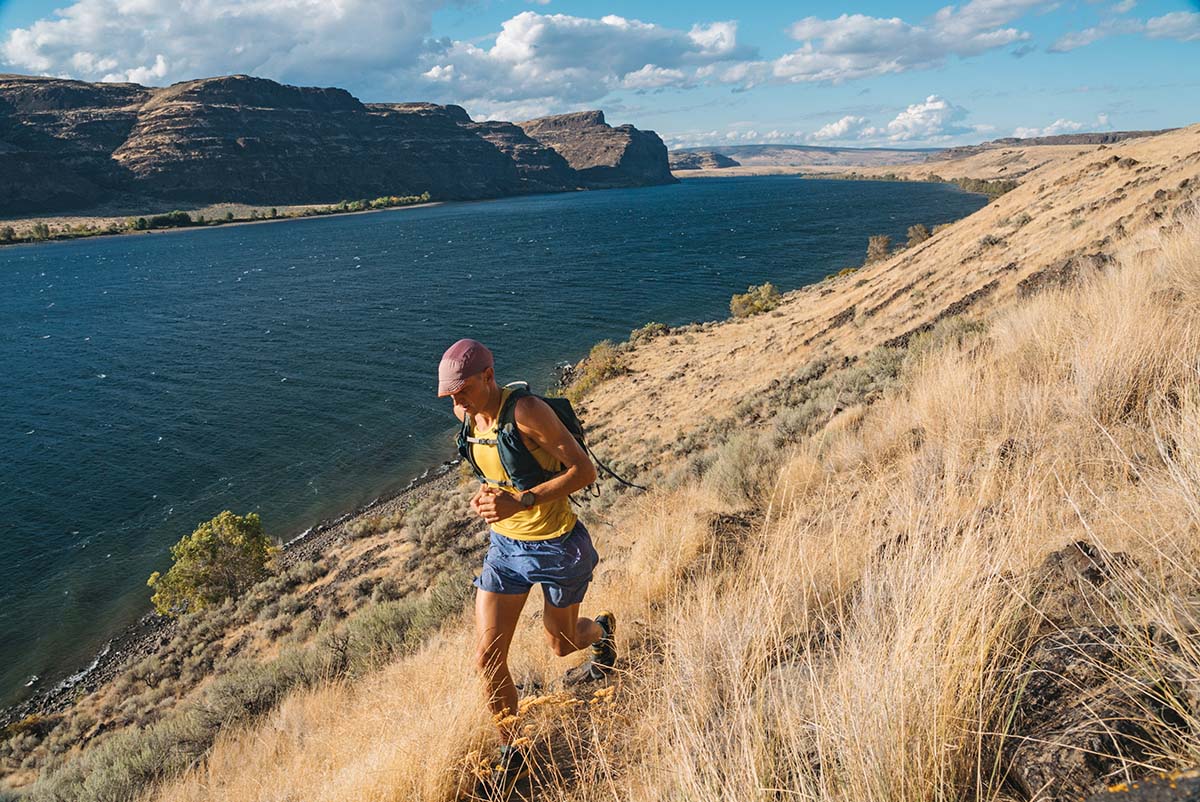
Flashlight
Honestly, it’s hard to call the Vertical flashlight a true flashlight. When you select the flashlight feature (the factory setting is a long press of the upper right button), the screen will light up. It’s bright enough to find a light switch in a dark room or locate your headlamp, but I hope I don’t ever have to use it on the trail in place of a headlamp. That said, I find I use it about as often as I would use my iPhone flashlight. It’s nice to have this option always available at my wrist, but in my opinion Suunto should call it something else or make it much brighter. Most wrist-based flashlights are very similar to that of the Vertical, but it’s worth noting that the Garmin Fenix 7X features a dedicated LED flashlight that offers real-deal brightness.
Sleep Tracking
I don’t often wear a watch to sleep, but during my testing period I wore the Vertical nightly for a number of weeks to get a sense of its sleep-tracking feature. Upon waking, the watch displays total sleep, heart rate average, lowest heart rate, HRV data, time awake (i.e., getting up to go to the bathroom, tossing and turning, etc.), and hours of deep sleep. This sleep info goes away after a few minutes but can be accessed by toggling to the sleep screen and pressing the down arrow to see the previous night's sleep stats. I found the sleep data to be a good proxy for how I felt after waking, confirming that listening to your body and your perception of how well rested you are matches physiological markers like heart rate and deep sleep duration.

The Suunto Vertical has 32 GB of internal storage, which can be used for downloaded maps, added widgets, future firmware updates, and more. With this amount of storage, it would be nice to also be able to upload music onto the watch, but the Vertical does not have capability for music storage (it can, however, be used to control music playing from your phone). For comparison’s sake, the Coros Vertix 2S also offers 32 GB of internal storage (and no music storage), while standard versions of the Garmin Fenix 7 has 16 GB of storage, split between both maps and music (the Fenix 7 Sapphire Solar has 32 GB).
I tested the titanium version of the Vertical, which features a titanium (Grade 5) bezel and glass fiber-reinforced polyamide case, which combine for an impressively lightweight (2.6 oz.) and durable watch. The sapphire crystal watch face is very scratch-resistant and hasn’t been marked up in months of heavy use, despite spending a lot of time around granite. What’s more, I’ve found the 22-millimeter silicone strap to be comfortable and easy to adjust, and it’s also easy to replace. Although the Vertical is on the larger side of watch faces, the low profile and light weight make it feel very manageable for daily wear, especially compared to competitors like the Fenix 7 and Vertix 2. And if you’re willing to give up the high-end look of titanium and don’t need the boost in durability or weight-savings, the Vertical also comes in a stainless steel version, which is significantly cheaper at $629 and weighs 3 ounces.
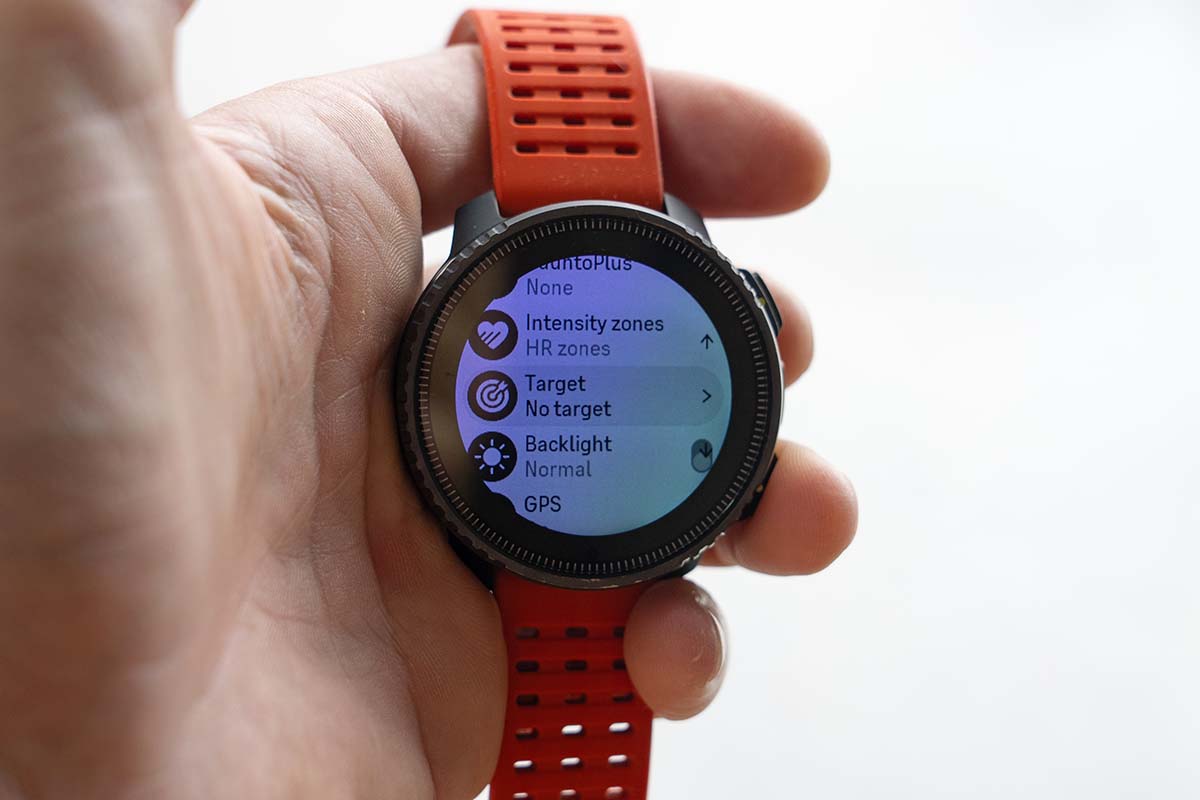
In terms of the Vertical’s internal durability, I have dealt with a few strange glitches. At least two times after I pulled the fully charged watch off the charger, the screen went black and the watch would not wake up. About an hour later, the watch face was back on and seemingly fine. On another occasion, the watch suddenly stopped recording an activity without pausing or saving. Finally, out of the box, the Vertical had a noticeable lag in response time between when a button is pressed and when the watch responds. However, Suunto’s 2.30.26 update (released in mid-November 2023) made the user interface much more responsive—since I downloaded the new firmware, swiping through screens and selecting items is now comparable to other touchscreen interfaces.
For this review, I tested the Suunto Vertical Titanium Solar. Suunto also makes the standard Vertical, which forgoes solar power and uses a stainless steel bezel instead of titanium. As a result, its battery life is noticeably reduced at 65 hours in multi-band GNSS mode (compared to the Titanium Solar's 90 hours), and it's 0.4 ounces heavier. It's also available with solar charging for $699, which ups battery life to 90 hours (the same as the titanium model). Beneath the hood, the watches are identical. In other words, a final decision will come down to how hard you are on your gear (in which case we recommend spending up for the titanium bezel) and whether or not you want solar charging capabilities.
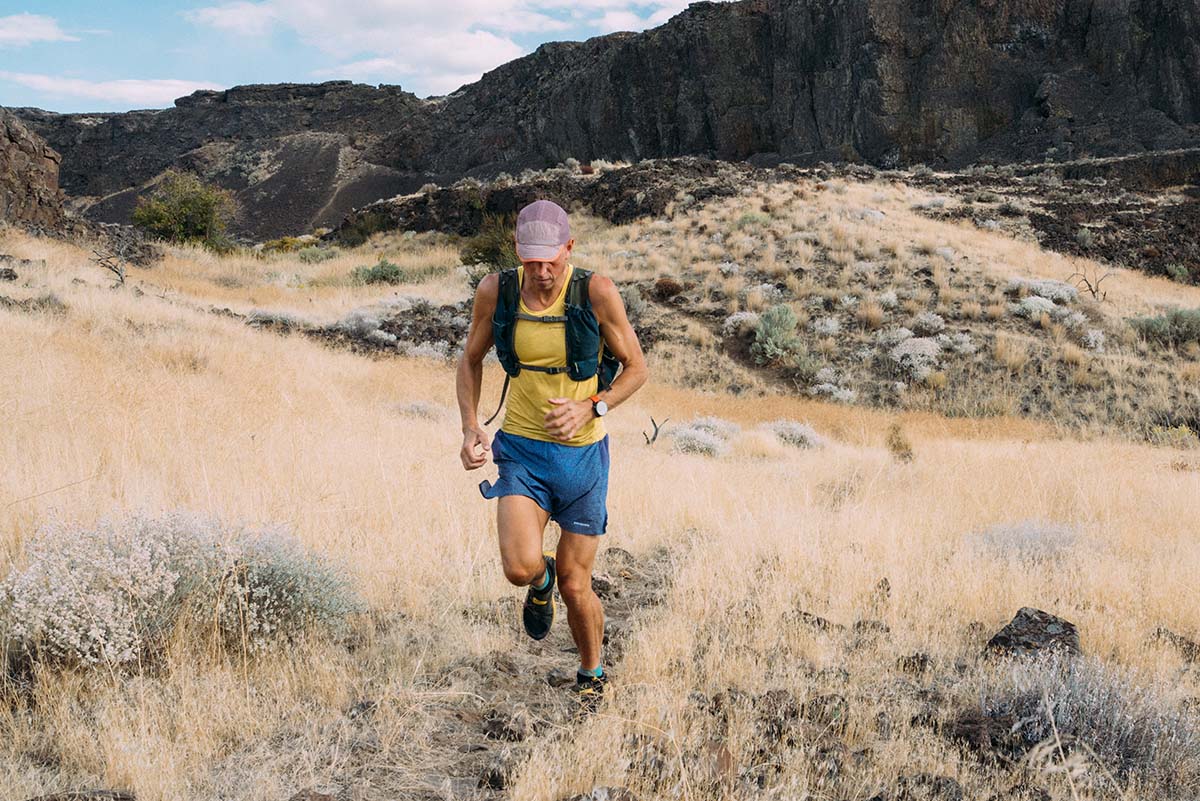

| Watch | Price | Weight | Battery* | Solar | Diameter(s) | Materials |
|---|---|---|---|---|---|---|
| Suunto Vertical Titanium Solar | $839 | 2.6 oz. | 90 hours | Yes | 49mm | Titanium/sapphire |
| Garmin Fenix 7 Sapphire Solar | $800 | 2.6 oz. | 26 hours | Yes | 42, 47, 51mm | Titanium/sapphire |
| Garmin Forerunner 955 Solar | $600 | 1.9 oz. | 22 hours | Yes | 46.5mm | Polymer/Gorilla Glass |
| Coros Vertix 2S | $699 | 3.1 oz. | 43 hours | No | 50.3mm | Titanium/sapphire |
| Suunto Race Titanium | $549 | 2.4 oz. | 50 hours | No | 49mm | Titanium/sapphire |
Editor’s note: The stated battery life is the manufacturer’s claim while in all-systems GNSS mode with multi-band GPS and solar charging (when applicable). Changes to the settings, features, and type of tracking will affect this number.
Among expedition-level fitness watches, Garmin’s venerable Fenix 7 series sits at the top of the food chain. The Fenix 7 Sapphire Solar is the closest competitor to the Vertical, with a titanium bezel, solar power, dual-band GNSS support, and a similar overall feature set. But the Fenix goes an extra mile with the best mapping tech available (the routable maps functionality isn’t too dissimilar to Google Maps), along with Garmin’s ClimbPro feature, which is a very useful tool for hilly routes and races. It’s also hard to beat Garmin’s refined ecosystem, offline music storage, and health and wellness tracking and features. Finally, the Fenix 7 Sapphire Solar is $40 less for the 42 and 47mm versions (the 51mm size is $900). We give the overall edge to the more established Garmin, but the Vertical isn’t far behind and its classier appearance will be enough to sway many users.
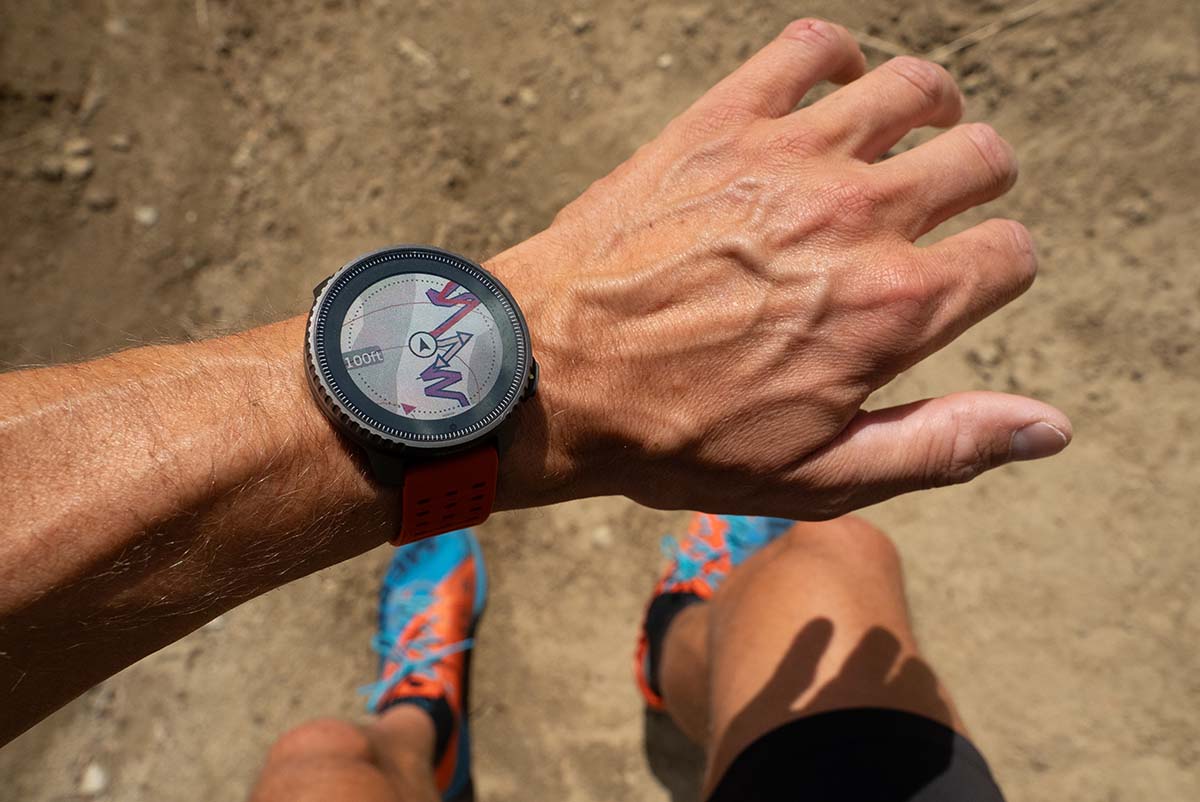
Another Garmin worth considering is the Forerunner 955 Solar. First off, the Forerunner is by no means an expedition watch—it lacks the durable build of the Vertical and has a much shorter battery life (22 hours with dual-band GNSS compared to the Suunto’s 90 hours). But the flip side is that it’s noticeably lighter (1.9 oz.) and more streamlined (including a 46.5mm display), which makes it a better option for endurance athletes who don’t want a heavy time piece on their wrist. The Garmin also features routable maps and tacks on the option to store and control music, which is a great feature for those who like to run (or do any activity) without their phone. It’s certainly not as durable or long lasting as the Vertical Titanium Solar, but for $240 less, the Forerunner 955 Solar is a better match for many users.
Coros has recently become a key player in fitness watches, and their Vertix 2S is a solid competitor to the Vertical Titanium Solar. These two watches go tit for tat in a number of departments: They both feature all-satellite dual-frequency GNSS support, solar power, 32 GB of storage, music control (but not storage), and a titanium bezel with sapphire touchscreen. Like the Suunto, the Coros’ maps are non-routable and lack place names, so neither measure up to Garmin in terms of maps and navigation. But the Vertical gets the edge in terms of battery life, with a listed 90 hours in dual-frequency GNSS mode compared to the Vertix’s 43. What’s more, with a smaller watch face, 0.5-ounce-lighter build, and svelter overall design, it’s the more versatile of the two. But the Vertix still has a lot going for it, and it’s more affordable at $699.

Finally, we’d be remiss not to mention Suunto’s newest watch, the Race. The Race’s headlining feature is its bright and highly contrasted AMOLED touchscreen. Many watches are going this direction, including the Forerunner 965, and a lot of users will prefer the modern look and feel. But in almost every other metric, the Suunto Race parallels the Vertical, including a 49-millimeter display, titanium bezel, (a stainless steel option is also available for $100 less), and sapphire lens, along with 32 GB of storage and the same mapping functionality. With all that in mind, the Race’s $549 price point is a remarkable feat—you’d be hard pressed to find a more competitively priced watch. Not all backcountry goers will want an AMOLED screen (it can disrupt night vision and wildlife and doesn’t necessarily scream “nature experience”) and the Race’s battery life is about half that of the Vertical, but it’s nevertheless a high-value option for those in the market for a feature-rich sports watch that also fits the part for everyday wear.